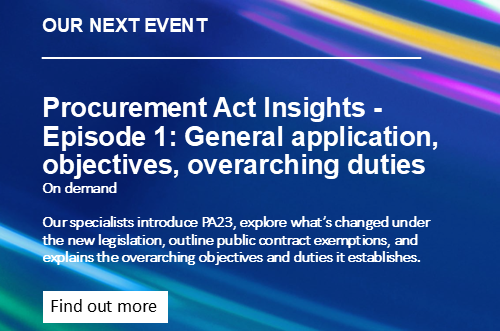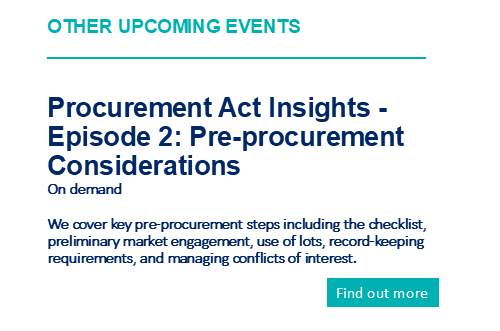- Details
The final act that marks the beginning: the Procurement Act 2023
![]() As a starting point for navigating the new procurement regime, Juli Lau identifies some key themes which are particularly relevant to public authorities.
As a starting point for navigating the new procurement regime, Juli Lau identifies some key themes which are particularly relevant to public authorities.
The Procurement Bill was given Royal Assent on 26th October. Whilst the majority of the provisions of the Procurement Act 2023 (the ‘Act’) are not yet in force, with Cabinet Office suggesting a ‘go-live’ date for the new regime of October 2024, it is important for those involved in public procurement to start becoming acquainted with the Act, particularly as it provides the basis for secondary legislation, guidance and electronic registers under the new regime.
A single Act
The Procurement Act repeals the Public Contracts Regulations 2015 (the ‘PCR’), Utilities Contracts Regulations 2016, Concessions Contracts Regulations 2016 and the Defence and Security Public Contracts Regulations 2011, and consolidates these into a single piece of primary legislation. Therefore all public authorities who currently carry out functions under these regulations will need to become familiar with the Act. The Act will also be bolstered by secondary legislation and guidance.
New Procurement Objectives
Section 12 of the Act introduces procurement ‘objectives’, replacing the concept of the ‘principles of procurement’ found in Regulation 18 of the PCR. These are:
- delivering value for money;
- maximising public benefit;
- sharing information for the purpose of allowing suppliers and others to understand the authority’s procurement policies and decisions;
- acting, and being seen to act, with integrity.
- treating suppliers the same unless a difference between suppliers justifies different treatment
- having regard to ‘the fact that small and medium-sized enterprises (‘SMEs’) may face particular barriers to participation, after which they should ‘consider whether such barriers can be removed or reduced’
In relation to the fifth bullet point above, s12 clarifies that ‘if the contracting authority considers that different treatment is justified in a particular case, [they] must take all reasonable steps to ensure [they] do not put a supplier at an unfair advantage.’
Contracting authorities should be aware of this move away from European ‘Treaty principles’ and look out for any future guidance on their practical application.
Competitive Flexible Procedure
The new competitive flexible procedure (s20(2)(b)) is a consolidation of the restricted procedure, competitive procedure with negotiation, competitive dialogue, innovation partnership and design contests, under current procurement regulations.
The Act retains features of procedures under the PCR:
- The Open Procedure (s20(2)(a)).
- Light Touch Contracts (s9), are granted a relaxation of the rules akin to the ‘light touch regime’ in Schedule 3 of the PCR).
- The Negotiated Procedure without Prior Publication in regulation 32 of the PCR is captured through Direct Award Procedures in the Act: the ‘Direct award in special cases’ (s41 & Schedule 5), the ‘Direct award to protect life, etc’ (s42) and ‘Switching to direct award’ (s43).
Notice Requirements
The Act introduces different notices and new publication requirements. These include:
- Planned procurement notice (if used) – s15,
- Pipeline notice (where applicable) – s93,
- Preliminary market engagement notice (where applicable) – s17,
- Tender notice – s21,
- Below threshold tender notice (where applicable) – s87,
- Dynamic market notice (where applicable) – s39,
- Transparency notice, where direct awarding in special cases and switching to direct award – s44,
- Contract award notice – s50,
- Contract details notice – s53,
- Contract change notice (where applicable) – s75,
- Payments compliance notice – s69, and publication of information about payments over £30k – s70,
- Procurement termination notice – s55,
- Contract termination notice – s80.
- Contracting Authorities (with some exceptions) must set and publish KPIs before entering into a public contract estimated over £5m – s52.
- Contracting Authorities must publish information about supplier performance – s71.
Public Authorities should become familiar with these new publishing requirements and ensure internal policies and electronic portals are updated accordingly.
More generally, s98 states that contracting authorities must keep records of the rationale behind any material decisions they make when awarding public contracts. They must also keep records of any communication between themselves and the suppliers that is made in relation to the award, before the contract is entered into. Note that this section does not apply to defence and security contracts.
Contract modifications
S74 provides grounds on which modifications to an existing contract are justified under the Act.
Permitted contract modifications: these are listed at Schedule 8, and are cases where there is:
- A modification which was provided for in the contract – Note that the modification must be ‘“unambiguously” provided’.
- Urgency and the protection of life.
- Unforeseeable circumstances.
- Materialisation of a known risk.
- Additional goods, services or works.
- Transfer on corporate restructuring.
- Defence authority contracts.
Modifications that are not substantial: S74(3) of the Act states that a ‘substantial modification’ (which would trigger a new procurement) is a modification which would –
- Increase or decrease the term of the contract by more than 10% of the maximum term provided for on award,
- Materially change the scope of the contract, or
- Materially change the economic balance of the contract in favour of the supplier.
There is therefore no longer a need to consider the impact on the outcome of the initial procurement process.
S74(4) defines below-threshold modifications:
- The increase or decrease of the estimated value of the contract would be by no more than 10% (for goods/services contracts) and 15% (for works contracts),
- The aggregated value of below-threshold modifications would be less than the threshold amount for the type of contract, and
- The modification is not listed in Schedule 8 or is a substantial modification.
In ‘live’ procurements where the contract term is likely to extend beyond October 2024, parties should pay close attention to upcoming secondary legislation on transitional provisions, including any guidance on the application of the grounds for lawful modification under s74.
Intersection with s17 of the Local Government Act 1988 (the ‘LGA’)
S17(11) of the LGA contains an exemption to the prohibition on including ‘non-commercial considerations’ in procurement, insofar as these are to fulfil duties under Social Value Act. This exemption now extends to compliance with the Procurement Act, through s116.
Further, the Act contains a power (at s116(2)) for Ministers to make regulations to disapply s17 LGA when required. In its Part 1 Consultation in June 2023, Cabinet Office stated that ‘the provisions are particularly drafted to disapply the part of the LGA that prevents contracting authorities from taking into account a supplier’s location when awarding contracts. This is another item to look out for in secondary legislation.
What next for public authorities?
In addition to getting familiar with the intricacies of the Act, keeping a close eye on guidance such as Procurement Policy Notes and on secondary legislation pending the outcome of the two public consultations, it will be important to keep up to date with communications from Cabinet Office on their learning and development programmes.
We advise contracting authorities on all manner of issues relating to public procurement and our experts are on hand to guide authorities through the intricacies of running a procurement and responding to procurement challenges, including in the context of the new regime.
For further insight and resources on local government legal issues from Sharpe Pritchard, please visit the SharpeEdge page by clicking on the banner below.
This article is for general awareness only and does not constitute legal or professional advice. The law may have changed since this page was first published. If you would like further advice and assistance in relation to any issue raised in this article, please contact us by telephone or email
|
Click here to view our archived articles or search below.
|
|
ABOUT SHARPE PRITCHARD
We are a national firm of public law specialists, serving local authorities, other public sector organisations and registered social landlords, as well as commercial clients and the third sector. Our team advises on a wide range of public law matters, spanning electoral law, procurement, construction, infrastructure, data protection and information law, planning and dispute resolution, to name a few key specialisms. All public sector organisations have a route to instruct us through the various frameworks we are appointed to. To find out more about our services, please click here.
|
|
OUR RECENT ARTICLES
December 10, 2025
Sharpe Pritchard appointed to £60m London Boroughs’ Legal Alliance frameworkSharpe Pritchard, one of the UK’s leading public law firms, has been re-appointed to the London Boroughs’ Legal Alliance (LBLA) Solicitors Panel.
November 20, 2025
Strengthening the standards and conduct framework for local authorities in EnglandJames Berry offers his insight into how the proposed changes to standards and conduct rules will affect local authorities.
November 04, 2025
Procuring and operating open frameworks under the Procurement Act 2023Chantelle Pink offers advice to authorities on open frameworks and how to procure them.
October 31, 2025
Building Solar – 5 Top Tips for Solar Farm Construction ContractsSolar farm construction contracts are in focus following fascinating insights into the continuing global uptake and expansion of renewables, and particularly solar, within the 2025 mid-year report of Ember, a global energy think tank.
|
|
OUR KEY LOCAL GOVERNMENT CONTACTS
|
||
|
Partner 020 7406 4600 Find out more |
||
|
Partner 020 7406 4600 Find out more |
||
|
Rachel Murray-Smith Partner 020 7406 4600 Find out more |







 Catherine Newman
Catherine Newman
